There are two fundamental approaches to 3D facial animation: key framing and parameterization
Each has been exploited with varying degrees of success, but both have drawbacks
Motivation
This research is concerned with the development of a more general and flexible muscle model for parameterization that will allow facial control without the requirement for hard-wiring the performable actions.Developing parameter sets for the face
Parameterization is the most desirable method of generating and controlling complex articuated models. Isolating the appropriate parameters to use for the face is perplexing but fundamental.The Facial Action Coding System (FACS), created by Paul Ekman and Wallice Friesden, is a notational-based environment that determines emotional states from the visible facial distortion. Individual muscles, or small groups of muscles are described as Action Units (AU) that distort the skin tissue. This appears to be the best technique for the extraction of facial parameters useful for computer synthesis.
The 50 independent facial actions can give rise to several thousands of muscle
combinations. The facial muscles can be trained, but activating them alone is
not visually communicative.
Six categories are described by Ekman:
Anger, Fear, Surprise, Disgust, Happiness, Sadness.
Each of these use mutiple combinations of the Action Units.
Waters research ascribes, to individual muscles, or groups of muscles, particular
parameters that remain consistant between one face and the next, in the same
way that FACS is universal accross a spectrum of facial types.
The goal is to model the basic facial expressions described by Ekman using FACS
to validate the results.
The muscle and bone of the face
The muscles of facial expression, are subcutaneous voluntary muscles. In general they arise from the bone or facia of the head, and insert into the skin. The muscle can be defined according to the orientation of the fasciculi (= the individual fibers of the muscle) that may be:- parallel/lineair
- oblique
- spiralized
- lower face. There are 5 major groupings:
- uppers and downers
- those that contract horizontally
- oblique muscles
- the orbitals
- sheet muscle
- upper face. Is responsible for the changing appearance of the:
- eyebrows
- forehead
- upper and lower lids of the eyes
The muscles of mouth have the most complex muscular interaction. The primary muscle being the Obicularis Oris -- a sphincter muscle with no bony attachment.
Factors determining the modelling of muscles
It is evident that the skin, being supported by bone and multiple layers of muscle, produces literally thousands of movement combinations. What is required is not the exact simulation of neurons, muscles and joints, but a model with a few dynamic parameters that emulate the primary characteristics. These parameters are relatively abstract, and do not attempt to model the biomechanical or neurophysiological mechanisms. Since the muscle themselves are grouped together to perform specific tasks, two broad types of muscles are considered:- linear/parallel muscles that pull
- sphincter muscles that squeeze
- Tensile strength of the muscle and skin
- Proximity to the muscle node of attachement
- Depth of tissue at the node and the proximity to the bone
- The elastic bounds of the relaxed tissue, and the interaction of other muscles
The computer model of muscles for the face
The fundamentals of most facial muscles determine that one end of a lineair muscle has a bony attachment that remains static, while the other end is embedded in the soft tissue of the skin. When the muscle is operated, it contracts isotonically.Looking at the concept of Muscle vectors, the zone of influence in the simplest form can be viewed as circular, and the fall-off is along the radius on the 3D grid. Muscle vectors can be described with direction and magnitude, both in 2D and 3D. The direction is towards the point of attachement, and the magnitude that is zero at the point of attachment and increases to maximum at the other point of insertion into the skin.
Waters found that his model could produce good results for the various human emotions.
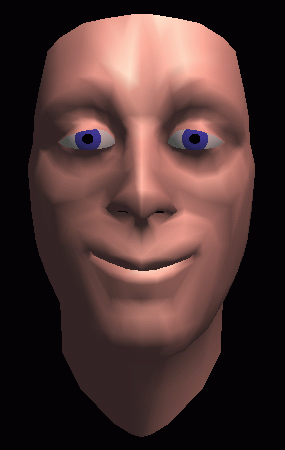
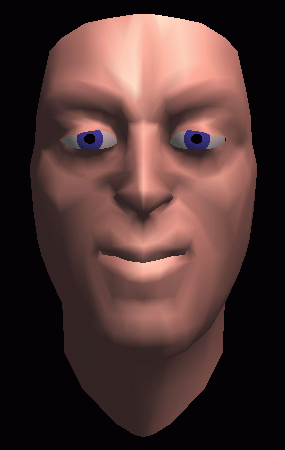
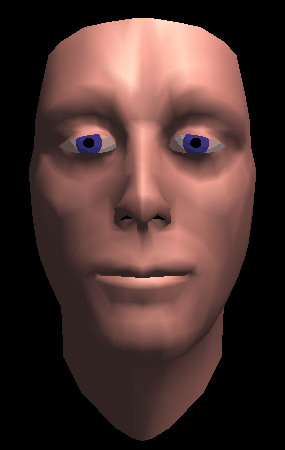
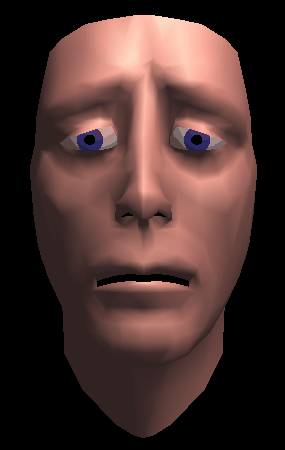
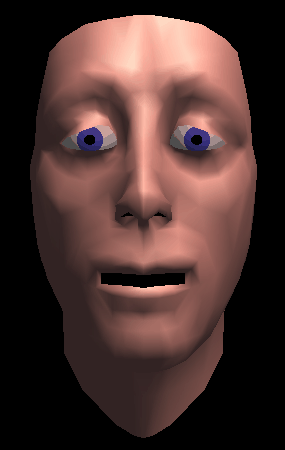
The above images were generated using the Water's Model.
A slight variation of this model was proposed by Reeve.
Reeves Model
Reeves describes the imposition of a further higher level of control in the form of macromuscles. A macromuscle is a collection of lower level muscles each of which is assigned an individual scaling parameter or weight. Contraction of the muscle would translate down to the lower level where the muscles would undergo contraction weighed by the proper amount. This causes a group of muscles to behave in a coordinated fashion.
An example of an application of the Reeves Model is the Pixar Oscar Winning animation Tin Toy

